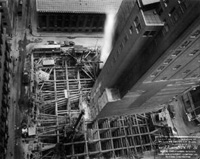The Skyscraper Museum is devoted to the study of high-rise building, past, present, and future. The Museum explores tall buildings as objects of design, products of technology, sites of construction, investments in real estate, and places of work and residence. This site will look better in a browser that supports web standards, but it is accessible to any browser or Internet device.
The Skyscraper Museum's VIRTUAL ARCHIVE
The Virtual Archive is a project to identify, inventory, and create a database of important historical records relating to skyscrapers and their urban milieu. The database for the Bankers Trust Collection is the first phase of the project. It has been made possible by generous funding from the Graham Foundation for Advanced Studies in the Fine Arts.

The Virtual Archive is a long-range effort to collect documents relating to the development, design, construction, operation, and occupation of high-rise buildings. The aim is to preserve a wide range of materials that are not commonly collected by the major archives specializing in architecture and design, or that are in danger of being lost. This material will include records of construction companies, engineers, building owners and managers, trade associations, and other areas. The focus of the pilot study is buildings and resources in New York City.
Mission StatementThe Skyscraper Museum has begun a pilot project to identify, inventory, and create a database of important historical records relating to skyscrapers and their urban milieu. This is the first phase of a long-range effort that will be part of the museum's ongoing mission, once established in a permanent home, to collect documents relating to the development, design, construction, operation, and occupation of highrise buildings. The aim is to identify and preserve a wide range of materials that are not commonly collected by the major archives specializing in architecture and design, or that are in danger of being lost. This material will include records of construction companies, engineers, building owners and managers, trade associations, and other areas. The focus of the pilot study is buildings and resources in New York City.
Through its research for exhibitions, The Skyscraper Museum has contacted numerous businesses, building owners and managers, and trade associations to identify important documents still in their hands. For example, for its inaugural exhibit Downtown New York, the curator borrowed photographs and other historical documents from the building managers' offices of the Woolworth Building and the Banker's Trust Tower (14 Wall Street).
The museum's 1998 exhibition, BUILDING THE EMPIRE STATE, was accompanied by a book of the same title edited by Carol Willis and published by W. W. Norton; this is a facsimile of a 1931 scrapbook (typescript and photographs) on the construction of the Empire State Building compiled by its general contractors Starrett Brothers and Eken. The in-house manuscript is a prime example of the kind of important historical documents the museum's pilot project aspires to save. One of several important items turned up by research for the museum's first show, it was located among the scant remaining files of HRH Construction, the successor firm of Starrett Brothers and Eken. Such material is in extreme jeopardy when companies like HRH move headquarters (as they did in December 1997) or are purchased by new owners (the sale of HRH is currently in negotiation). Our efforts will ensure that many important items are not lost completely.
For example, the museum arranged for the large model of Lower Manhattan, loaned to its exhibition by the modelmaker's heirs, to be donated to the New-York Historical Society. Unfortunately, other important items, such as original photographs of the foundations of the Woolworth Building were, as requested, returned to the building manager's office. In these cases the museum was able to make copies, should the originals be lost by their owners.) Once the museum has in place the plan for its inventories and database, as well as its consultant and interns, it can begin systematic program of creating the virtual archive by scanning documents and photographs into digital files.
A sample list of sources for surveys includes: The Real Estate Board of New York, Ironworkers Local 40, New York Building Owners and Managers Association, Weiskopf and Pickworth (100-year old structural engineering firm), Grubb and Ellis, Cushman and Wakefield (long-established real estate brokers), Turner Construction, various building owner or managers. Organizations with which the museum will share and cross-reference material include: SEANY (Structural Engineers of New York), NYC Landmarks Commission, Friends of Terra Cotta; various business archives. In addition to the known and familiar sources in New York City, new sources for construction and real property financing and operating documents will be systematically identified. A list of national trade and professional associations, architects, contractors, and building owners compiled by project consultant Derek Trelstad, the former editor of Building Renovation, will be used to investigate new sources. Direct queries to architectural, construction, and real estate firms will be supplemented with broadcast solicitations published in the trade journals, magazines, and newsletters of the industry.
The aim of the project is to identify, inventory, and preserve materials that either are not commonly collected by the major archives specializing in architecture and design, or are in danger of being lost. Horror stories abound of the destruction of entire corporate archives or the files of professional offices due to lack of storage space, relocation, or disregard for their own history: recent examples apparently include the records of Crimmons Foundations. One aspect of the museum's search-and-salvage effort will be to contact long-established construction companies, real estate brokerage firms, trade associations, and other potentially rich sources of historical material.



